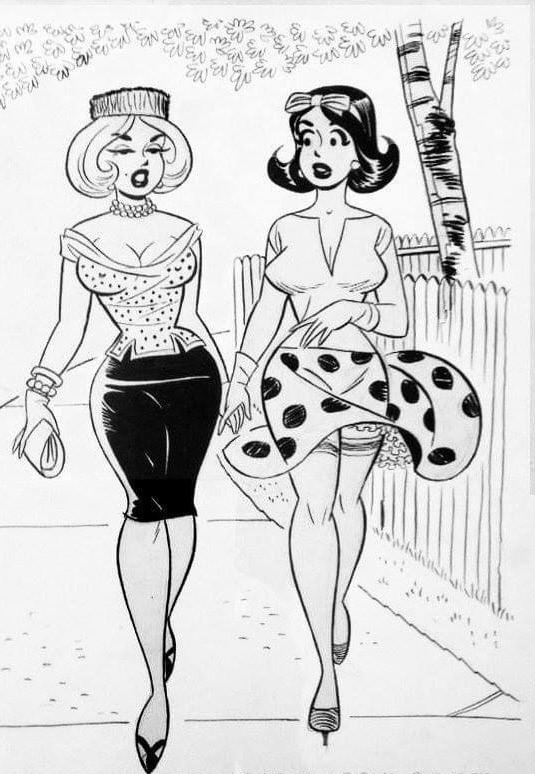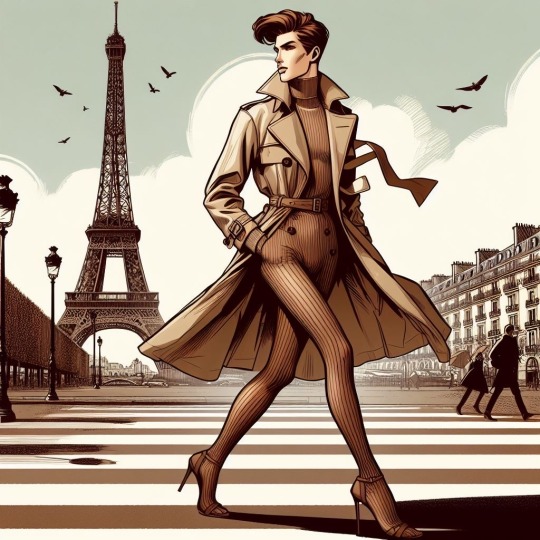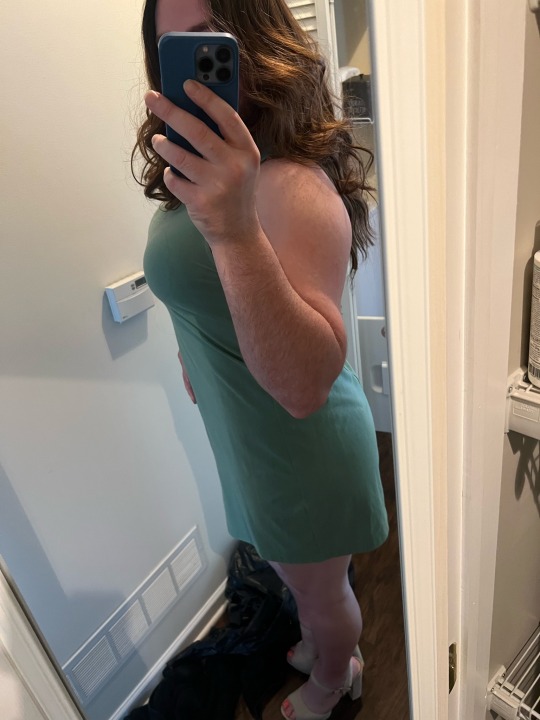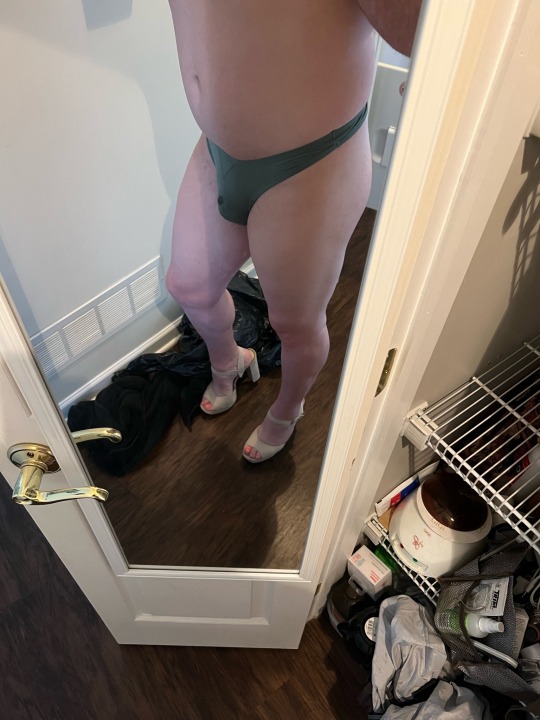#gender feminisation
Explore tagged Tumblr posts
Text

Well George that’s the last time I go to a hypnotist show ❤️❤️🤣
4 notes
·
View notes
Note
can you share what breast forms you use please? :O
Of course!
Here is a list of some various shapewear things I use as an AMAB Genderfluid person:
Chest Stuff - Breast forms: https://a.co/d/3Ph0LBW - Cheap bra that I use most days: https://a.co/d/08kTI2v - Larger, full coverage bra that is more supportive: https://a.co/d/dtKLRXm
You can just slot the breast forms into the bra. Make sure to measure your band size so you get the right size. I would recommend starting smaller to average size (B/C cup) as larger breasts can be harder to make more casual outfits with (they're also just heavier).
Hip Stuff - The short hip pads I use (though they are currently unavailable): https://a.co/d/8apRadX - Longer hip pads that I use sometimes, they are sometimes too long for certain skirts, dresses, and shorts (also unavailable D:): https://a.co/d/iXXzvPJ - Butt pads: https://a.co/d/0zdzmZv
I can't attest for other hip pads, but I'm sure you can find similar to what I have!
#askeret#gender#genderqueer#genderfluid#amab = assigned male at birth#lgbtq+#you can also get silicone chest plates for more “showy” outfits#but they are so inconvenient and sweaty#Breast forms are the best and most convenient form of shapewear for me#they are the main thing I use to “feminise” my silhouette
379 notes
·
View notes
Text
there was some Twitter madness recently where someone left a comment on someone's art to the effect of, "Ed shouldn't wear a dress, he's a man!" which I do disagree with on principle, but unfortunately, it brought out one of my least favourite trends in the fandom
so, naturally, I had to write a twitter essay about it. and I already largely argued this in a post here, but the thread is clearer and better structured, so I thought I'd cross-post for those not on the Hellsite (derogatory). edited for formatting/structure's sake, since I no longer have to keep to tweet lengths, and incorporating a couple of points other people brought up in the replies
so
I want to point out that the wedding cake toppers in OFMD s2 aren't evidence that Ed wants to wear dresses. Gender is fake, men can wear skirts, play with these dolls how you like, but it's not canon, and that scene especially Doesn't Mean That.
People cite it often: 'He put himself in a dress by painting the bride as himself! It's what he wants!' But that fundamentally misunderstands the scene, and the series' framing of weddings as a whole. I'd argue that Ed paints the figure not from desire, but from self-hatred; it's not what he wants, but what he thinks he should, and has failed to, be.
(Yes, I am slightly biased by my rampant anti-marriage opinions, but bear with me here, because it is relevant to the interpretation of the scene, and season two as a whole.)
The show is not subtle. It keeps telling us that the institution of marriage is a prison that suffocates everyone involved. Ed's parents' cycle of abuse is passed to their son in both the violence he witnesses then enacts on his father, and the self-repression his mother teaches, despite her good intentions ("It's not up to us, is it? It's up to God. ... We're just not those kind of people. We never will be."). Stede and Mary are both oppressed by their arranged marriage, with 1x04 blunty titled Discomfort in a Married State. The Barbados widows revel in their freedom ("We're alive. They're dead. Now is your time").
But even without this context, the particular wedding crashed in 2x01 is COMICALLY evil. The scene is introduced with this speech from the priest:
"The natural condition of humanity is base and vile. It is the obligation of people of standing ... to elevate the common human rabble through the sacred transaction of matrimony."
It's upper class, all-white, and religiously sanctioned. "Vile natural conditions" include queerness, sexual freedom, and family structures outside the cisheteropatriarchal capitalist unit. "The obligation of people of standing" invokes ideas like the white man's burden, innate class hierarchy, religious missions, and conversion therapy. Matrimony is presented as both "sacred" (endorsed by the ruling religious body), and a "transaction" (business performed to transfer property and people-as-property, regardless of their desires), a tool of the oppressive society that pirates escape and destroy. That is where the figurines come from.
When Ed, in a drunk, depressive spiral, paints himself onto the bride, he's not yearning for a pretty dress. He's sort of yearning for a wedding, but that's not framed as positive. What he's doing is projecting himself into an 'ideal' image of marriage because he believes that: a) that's what Stede (and everyone) wants; b) he can never live up to that ideal because he's unlovable and broken (brown, queer, lower-class, violent, abused, etc); c) that's why Stede left. He tries to make himself fit into the social ideal by painting himself onto the closest match - long-haired, partner to Stede/groom, but a demure, white woman, a frozen, porcelain miniature - because, if he could just shrink himself down and squeeze into that box, maybe Stede would love him and he'd live happily ever after. But he can't. So he won't.
The fantasy fails: Ed is morose, turns away from the figurines, then tips them into the sea, a lost cause. He knows he won't ever fulfil that bride's role, but he sees that as a failure in himself, not the role. It's not just that "Stede left, so Ed will never have a dream wedding and might as well die." Stede left when Ed was honest and vulnerable, "proving" what his trauma and depression tell him: there's one image of love (of personhood), and he'll never live up to it because he's fundamentally deficient. So he might as well die.
This hit me from my very first viewing. The scene is devastating, because Ed is wrong, and we know it! He doesn't need to change or reduce himself to fit an image and be accepted (as, eg, Izzy demanded). Stede knows and loves him exactly as he is; it's the main thread and theme of season two!
(@/everyonegetcake suggested that Ed's yearning in these scenes includes his broader desire for the vulnerability and safety Stede offered, literalised through unattainable "fine" things like the status of gentleman in s1, or the figurine's blue dress. I'd argue, though, that these scenes don't incorporate this beyond a general knowledge of Ed's character. Ed is always pining for both literal and emotional softness, but the significance of the figurines specifically, to both Ed and the audience, is poisoned by their origin and context: there is no positive fantasy in the bride figure, only Ed's perceived deficiency.
Further, assuming that a desire for vulnerability necessarily corresponds with an explicit desire for femininity, dresses, etc, kind of contradicts the major themes of the show. OFMD asserts that there is nothing wrong with men assuming femininity (through drag, self-care, nurturing, emotional vulnerability, etc), but also that many of these traits are, in fact, genderless, and should be available to men without affecting their perceived or actual masculinity. It thematically invokes the potential for cross-gender expression in Ed's desires, especially through the transgender echoes in his relieved disposal, then comfortable reincorporation, of the Blackbeard leathers/identity. It's a rich, valuable area of analysis and exploration. But it remains a suggestion, not a canon or on-screen trait.)
Importantly, the groom figure doesn't fit Stede, either. Not just in dress: it's stiff and formal, and marriage nearly killed him. He's shabbier now, yes, but also shedding his privilege and property, embracing his queerness, and trying to take responsibility for his community. In a s1 flashback, Stede hesitantly says, "I thought that, when I did marry, it could be for love," but he would never find love in marriage. Not just because he's gay, but because marriage in OFMD is an oppressive, transactional institution that precludes love altogether. All formal marriages in OFMD are loveless.
So, he becomes a pirate, where they reject society altogether and have matelotages instead. Lucius and Pete's "mateys" ceremony is shot and framed not like a wedding, but as an honest, personal bond, willingly conducted in community (in a circle; no presiding authority, procession, or transaction).
That is how Stede and Ed can find love, companionship, and happiness: by rejecting those figurines and their oppressive exchange of property, overseen by a church that enables colonialism and abuse. Ed is loved, and deserves happiness, as he is, no paint or projection required.
ALL OF THIS IS TO SAY: draw Ed in dresses! Write him getting gender euphoria in skirts! Write trans/nb Ed, draw men being feminine! Gender is fake, the show invites exploration, that's what 'transformative works' means! But please, stop citing the cake toppers as evidence it's canon. Stop citing a scene where a depressed Māori man gets drunk and projects himself onto a rich, white, silent bride because he thinks he's innately unlovable and only people like her can find happiness, shortly before deciding to kill himself, as canon evidence it's what he wants.
(Also, please don't come in here with "lmao we're just having fun," I know, I get it. Unfortunately, I'm an academiapilled researchmaxxer, and some of youse need to remember that the word "canon" has meaning. NOW GO HAVE FUN PUTTING THAT MAN IN A PRETTY DRESS!! 💖💖)
#OFMD#Our Flag Means Death#OFMD Edward Teach#gender stuff#Togas does meta#god this seems even longer as a semi-proper essay XD#I know this is the piss on the poor website of reading comprehension but please god don't misunderstand me#i'm not saying you can't draw ed (or any other male character!) in a dress or that it's The Wrong Interpretation or whatever#I AM saying this fandom sometimes emphasises feminising Ed to the point of over-simplification and dehumanisation#which certainly feels at least racist-adjacent and definitely misses the point of the show#but mostly I'm saying that THAT SCENE DOESN'T MEAN THAT and I wish people would stop talking about it like something sweet and positive#when it's one of the most miserable and heartbreaking scenes in the show. like. agreeing with ed's depression is a bad look...#my experience of trying to do meta in the last year or so has consisted almost entirely of trying to do#specific historicist analysis or textual close readings#and being met with broad political analyses and overall interpretations of character#like mate..... bless you for engaging but. that is not what I'm doing here. XD#shoutout to the couple folks on twt that mentioned Ed's desires generally or an outtake from the scene#neither of which are at all relevant to my point but thank you for your input
112 notes
·
View notes
Text

New podcast recapping the latest Fashion Week collections out now! Search "Future Fashion Icons" on all streaming platforms or click here!
Wishing you all an epic new week! 🌸🌸🌸
#Viktor & Rolf#male models#Paris Fashion Week#twink#feminised#Viktor And Rolf#nb#gender fluid#artists on tumblr#androgyny#aw24#yaoi#black pantyhose#femboy#girlslikeus#floral#runway#feminized sissy#sissi femboi#Milan Fashion Week
84 notes
·
View notes
Text
good for the transmasc bloggers having fun with the "forcemasc" images but those don't seem very forced to me. which is also why they're not very sexy
#it's more like gentle encouragement masc. affirmation masc.#i just don't get the appeal sorry. forcemasc as a concept is already tricky because according to gender roles masculinity is not passive#so forcefem makes more sense because being deprived of your agency fits the gendered stereotype of femininity#so forcemasc would have to call to a hierarchy in order to work without partially feminising the recipient of it due to making them passive#and well i don't see any of that in posts that are like 'you can just be a boy if you want to'#i appreciate the pictures of pretty boys though 👍
27 notes
·
View notes
Text

New “Best of Paris Fashion Week” podcast episode out now!!!!! Search “Future Fashion Icons” on any streaming platform or click here!
:)
#Paris Fashion Week#Alexander McQueen#menswear#editorial#enby#male models#gay#yaoi#nonbinary#comme des garçons#CDG#pantyhose#PFW#gender fluid#twink#pressiat#brown pantyhose#girlslikeus#feminised#issey miyake
60 notes
·
View notes
Text
There are two types of people attacking women for showing off and they have distinct reasons.
First are those who perceive themselves to be in competition with other women for the attention of men. They will attack women whom they perceive as putting overt effort into competing for male attention, and also women whose body shape causes them to be sexualized without putting in effort for failing to cover up their unfair advantage.
Second are men who see confident women as less attainable/controllable and therefore seek to attack the self-confidence of those they find attractive. This has the dual purpose of improving their own feelings of value while also making their target more likely to settle for a man who doesn't meet her own standard of beauty, fitness, and/or confidence.
In both cases the people who are attacking the woman are doing so as an expression of their awareness of their own inability to perform a similar display.
Men who are displaying they muscles, money, etc are not perceived as competitors because they are perceived as displaying that for male approval rather than as sexual competition.
These beliefs generally aren't conscious so the people hating on women and not men for what is essentially the same behavior aren't necessarily going to know why they hold this double standard as these are internalized expectations rather than conscious stated values. People who've confronted their own prejudices generally don't engage in negative comments about people showing off things they are proud of.
#liberal feminism#feminisierung#enforced feminisation#feminist#feminism#anti feminism#leftism#feminized husband#divine feminine#feminine sissy#hyper feminine#radical feminists do touch#anti capitalism#funny queue pun#intersectionality#conservatism#gender stereotypes#ideology#radical feminist community#radical feminists do interact#radical feminist safe#radical feminism#liberals#twitter post#republican#conservative#liberal hypocrisy#woke liberal madness#liberalism
11 notes
·
View notes
Text




When the panties match the dress ❤️❤️
3 notes
·
View notes
Text
remember: if a tgirl makes a joke about feminisation on the internet you HAVE to take it as a personal attack on your masculinity and YOUR gender identity specifically as if it was deliberately made about forcing you specifically to be a woman
4K notes
·
View notes
Text

#leftism#anti capitalism#twitter post#twitter x#anarchy#xitter#communism#rip twitter#socialism#tweet#liberal feminism#feminist#enforced feminisation#feminism#feminisierung#smash the patriarchy#patriarchy#misandry#male violence#gender ideology
2 notes
·
View notes
Note
pls stop feminizing idols if you're insecure in your own gender :) maybe try projecting on fictional people instead!
...... bestie who r u talking about 😭
#who am I feminizing? fnejsje#the only idols I've talked about today have been haobin and boa#am I feminising boa ???? fndjd#also bestie just .. don't go reading into things and providing a reason like I am secure in my gender#whatever I did that pissed u off has nothing to do with my own gender !!
0 notes
Text
a genre of fanwork ab two gay men where you can clearly see theres a woman in there
#ok ik this isnt the best wording#being brutally feminised doesnt make one a woman and feminine person can be in a gay relationship etc right#what is gender#but you know what i mean#honestly why do ppl do this?#are you making drawing two homos more morally acceptable to you#or are there some women creators who r trying to#idk#put themselves into the scene#jims#txt
0 notes
Note
Why are intersex people called 'collateral damage'? What does that even mean
Giving an example–
"Hermaphrodite" is an intersex slur. It has always been an intersex slur. Trans people cannot reclaim this slur because while it's been used against them, it's always been used against them to compare them to US.
People—even, ESPECIALLY the queer community—often ignore blatant intersexism in favour of calling it transphobia, even when it's blatantly targetting us specifically—for example, the idea that children AREN'T being put on hormones or given top or bottom surgery. The queer community likes to promote this as a thing that's not happening when in fact it is—it just happens to intersex kids. We are FORCED onto hormones, FORCED into genital mutilation, by an intersexist medical system. But in the defence of trans people, we are "collateral damage". Our medical abuse is ignored in favour of trans people promoting a lie that these things don't happen.
I was born visibly intersex. I had surgery at birth and then again at 12 days old. I DID NOT LEARN OF THIS UNTIL LAST YEAR. I AM TWENTY-THREE YEARS OLD. When my body began feminising at 12, it took TWO YEARS before my therapist would refer me to hospital for gender dysphoria. It took another six months to be put on testosterone and to have my ovary removed. I ended up needing top surgery at 16 to remove the breast tissue I grew. Most intersex people have the opposite experience—instead of being allowed to exist in their natural intersex body, they're forced into the hormones that "match" their assigned sex at birth. They are forced into surgeries WITHOUT THEIR CONSENT to make them look "normal".
Don't even get me started on the connotations of "assigned" sex. Perisex people have an OBSERVED sex at birth. Intersex people, if they have ambiguous genitalia like I did, are ASSIGNED a sex based on what the doctor thinks they can make them pass more easily for. Most are ASSIGNED female through mutilatory surgery as newborns, because it's easier to make a vulva and vagina than it is to make a penis. Do not get me started on how the brains of children process routine neovagina dilation (which must be done daily from the time the child is mutilated, usually at birth) as SEXUAL ASSAULT. That's right, for many intersex people, the medical system assigns you as female and then sexually abuses you until you stop growing.
In many countries, intersex people who identify as a sex different from their assigned sex at birth cannot seek out transgender care. If you are assigned female they will never allow you to go on testosterone, never be approved for top surgery, etc. If you are assigned male you will never be allowed to go on oestrogen or get bottom surgery, etc. The medical system ASSIGNED you your sex, and the medical system can never be wrong, can they. This in places where trans people can receive care. We are told it's transphobia, that intersex people are just collateral damage, when in reality these policies EXPLICITLY ARE MEANT TO AFFECT INTERSEX PEOPLE. When perisex people can receive trans healthcare but intersex people cannot, that is not transphobia, THAT IS INTERSEXISM.
Or for example someone calling a trans person a hermaphrodite, and a trans person trying to reclaim the term despite it being an INTERSEX slur. This intersexism is ignored, labelled transphobia instead, and intersex people are just told we aren't actually being attacked and that we're just collateral damage. It was an intersex slur first. They are comparing them to US.
Our experiences are ignored or outright erased. The queer community does not care for us. Even when we speak of blatant intersexism we experience, we are told that we are not the target and that we are just collateral damage.
2K notes
·
View notes
Text
Feminising Hormones
Today we live in a situation where access to feminising hormones is being restricted, especially for young people. In some cases, as in certain US States, this is the result of draconian and ill-advised legislation. In others, especially where prescriptions are needed to get the preparations, the technique has been to make this almost impossible. This is what happens, for example in the…

View On WordPress
1 note
·
View note